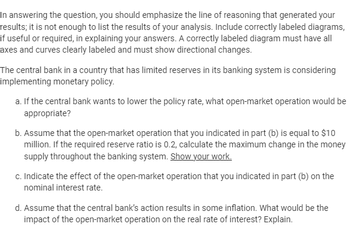
ENGR.ECONOMIC ANALYSIS
14th Edition
ISBN: 9780190931919
Author: NEWNAN
Publisher: Oxford University Press
expand_more
expand_more
format_list_bulleted
Concept explainers
Question

Transcribed Image Text:In answering the question, you should emphasize the line of reasoning that generated your
results; it is not enough to list the results of your analysis. Include correctly labeled diagrams,
if useful or required, in explaining your answers. A correctly labeled diagram must have all
axes and curves clearly labeled and must show directional changes.
The central bank in a country that has limited reserves in its banking system is considering
implementing monetary policy.
a. If the central bank wants to lower the policy rate, what open-market operation would be
appropriate?
b. Assume that the open-market operation that you indicated in part (b) is equal to $10
million. If the required reserve ratio is 0.2, calculate the maximum change in the money
supply throughout the banking system. Show your work.
c. Indicate the effect of the open-market operation that you indicated in part (b) on the
nominal interest rate.
d. Assume that the central bank's action results in some inflation. What would be the
impact of the open-market operation on the real rate of interest? Explain.
Expert Solution
arrow_forward
Step 1
A central bank is a financial institution that manages a country's monetary policy and oversees its banking system. Central banks typically have a mandate to ensure price stability and support economic growth. They are responsible for regulating the money supply, setting interest rates, and supervising commercial banks.
Central banks play a crucial role in ensuring the stability of the financial system and promoting economic growth. Their policies can have a significant impact on inflation, employment, and economic growth. As a result, central banks are closely watched by governments, financial markets, and the public.
Trending nowThis is a popular solution!
Step by stepSolved in 2 steps

Knowledge Booster
Learn more about
Need a deep-dive on the concept behind this application? Look no further. Learn more about this topic, economics and related others by exploring similar questions and additional content below.Similar questions
- If the president of the central bank in this economy is convinced that there is no need for any monetary policy actions for the economy recover from the pandemic. If his/her opinion is followed, explain whether you think the president’s opinion is good for the citizens of this economy?arrow_forwardAnswer this for me mate. Much appreciated.arrow_forwardThe Federal Open Market Committee can buy and sell government securities/bonds. Which of the following tools of monetary policy does this describe?arrow_forward
Recommended textbooks for you

 Principles of Economics (12th Edition)EconomicsISBN:9780134078779Author:Karl E. Case, Ray C. Fair, Sharon E. OsterPublisher:PEARSON
Principles of Economics (12th Edition)EconomicsISBN:9780134078779Author:Karl E. Case, Ray C. Fair, Sharon E. OsterPublisher:PEARSON Engineering Economy (17th Edition)EconomicsISBN:9780134870069Author:William G. Sullivan, Elin M. Wicks, C. Patrick KoellingPublisher:PEARSON
Engineering Economy (17th Edition)EconomicsISBN:9780134870069Author:William G. Sullivan, Elin M. Wicks, C. Patrick KoellingPublisher:PEARSON Principles of Economics (MindTap Course List)EconomicsISBN:9781305585126Author:N. Gregory MankiwPublisher:Cengage Learning
Principles of Economics (MindTap Course List)EconomicsISBN:9781305585126Author:N. Gregory MankiwPublisher:Cengage Learning Managerial Economics: A Problem Solving ApproachEconomicsISBN:9781337106665Author:Luke M. Froeb, Brian T. McCann, Michael R. Ward, Mike ShorPublisher:Cengage Learning
Managerial Economics: A Problem Solving ApproachEconomicsISBN:9781337106665Author:Luke M. Froeb, Brian T. McCann, Michael R. Ward, Mike ShorPublisher:Cengage Learning Managerial Economics & Business Strategy (Mcgraw-...EconomicsISBN:9781259290619Author:Michael Baye, Jeff PrincePublisher:McGraw-Hill Education
Managerial Economics & Business Strategy (Mcgraw-...EconomicsISBN:9781259290619Author:Michael Baye, Jeff PrincePublisher:McGraw-Hill Education


Principles of Economics (12th Edition)
Economics
ISBN:9780134078779
Author:Karl E. Case, Ray C. Fair, Sharon E. Oster
Publisher:PEARSON

Engineering Economy (17th Edition)
Economics
ISBN:9780134870069
Author:William G. Sullivan, Elin M. Wicks, C. Patrick Koelling
Publisher:PEARSON

Principles of Economics (MindTap Course List)
Economics
ISBN:9781305585126
Author:N. Gregory Mankiw
Publisher:Cengage Learning

Managerial Economics: A Problem Solving Approach
Economics
ISBN:9781337106665
Author:Luke M. Froeb, Brian T. McCann, Michael R. Ward, Mike Shor
Publisher:Cengage Learning

Managerial Economics & Business Strategy (Mcgraw-...
Economics
ISBN:9781259290619
Author:Michael Baye, Jeff Prince
Publisher:McGraw-Hill Education